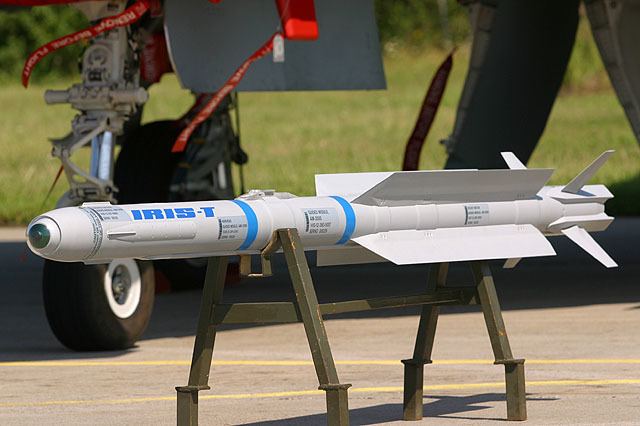In service December 2005 Manufacturer Diehl BGT Defence | Used by See operators Unit cost €0.38m (~US$455,000) | |
 | ||
Type Short-range air-to-air missile Place of origin German-led multinational armament program | ||
The IRIS-T (Infra Red Imaging System Tail/Thrust Vector-Controlled) is a German-led program to develop a short-range infrared homing air-to-air missile to replace the AIM-9 Sidewinder found in some NATO member countries. Any aircraft capable of firing the Sidewinder is also capable of launching the IRIS-T.
Contents
History
In the 1980s, NATO countries signed a Memorandum of Agreement that the United States would develop a medium-range air-to-air missile to replace the AIM-7 Sparrow, while Britain and Germany would develop a short-range air-to-air missile to replace the AIM-9 Sidewinder. The US design developed as the AIM-120 AMRAAM, while the UK-German design developed as the AIM-132 ASRAAM.
The roots of the ASRAAM dated back to 1968 when development began on the Hawker Siddeley SRAAM ('Taildog'), but this project ended in 1974 with no production orders. This work was dusted off for the UK/German effort, with the Germans providing a new seeker, and the British providing most of the remaining components. In the intervening time, the need for high maneuverability was downgraded in favor of greater range.
After German reunification in 1990, Germany found itself with large stockpiles of the Soviet Vympel R-73 missiles (NATO reporting name: AA-11 Archer) carried by the MiG-29 Fulcrum and concluded that the AA-11's capabilities had been noticeably underestimated. In particular, it was found to be both far more maneuverable, and far more capable in terms of seeker acquisition and tracking than the latest AIM-9 Sidewinder. In 1990 Germany withdrew from the ASRAAM project, while Britain resolved to find another seeker and develop ASRAAM according to the original requirements.
In late 1990, the US partnership expressed similar concerns and embarked on an upgrade to the existing Sidewinder design to provide increased maneuverability and IRCCM (infrared counter counter measures) performance, i.e. measures to counter infrared countermeasures (IRCM). This program was designated AIM-9X.
Missile characteristics
In comparison to the AIM-9L Sidewinder, the IRIS-T has higher ECM-resistance and flare suppression. Improvements in target discrimination not only allows for 5 to 8 times longer head-on firing range than the AIM-9L, it can also engage targets behind the launching aircraft, the latter made possible by the extreme close-in agility allowing turns of 60 g at a rate of 60°/s.
The Royal Norwegian Air Force (RNoAF) has tested a new air-to-surface capability developed by Diehl BGT Defence for the IRIS-T. A proof of concept test firing to acquire, track, and engage a target representing a small fast attack boat was conducted in Norway in September 2016, where the IRIS-T missile was launched from an RNoAF F-16AM multirole aircraft. For the air-to-surface role, the missile retains the same standard IRIS-T AAM hardware configuration, including the HE warhead and IIR guidance package, with only an updated software insertion required to deliver the additional ground attack capability. This basic air-to-ground capability provides the ability to acquire, track and engage individual ground targets like boats/ships, small buildings and vehicles.
Development partners
In 1995, Germany announced the IRIS-T development program, in collaboration with Greece, Italy, Norway, Sweden and Canada. Canada later dropped out, while in 2003 Spain joined as a partner for procurement. The German Air Force took first delivery of the missile on 5 December 2005.
Workshare arrangements for IRIS-T development are:
IDAS
The IDAS variant is a navalized version of the missile, is also being developed for the new Type 212 submarine of the German Navy. IDAS is supposed to engage air threats, small or medium surface vessels or near land targets.
IRIS-T SL
Within the MEADS program, the German Air Force plans to integrate a surface-launched (SL) radar-guided version of the missile, called IRIS-T SL. It has a pointed nose, unlike the regular IRIS-T. The IRIS-T SL qualification tests were completed during January 2015 at the Denel Overberg Test Range in South Africa. It is build in two variants IRIS-T SLS (short-range) and IRIS-T SLM (medium-range).
SAM Version
The Swedish Army plans to develop a ground launched version of the IRIS-T to replace the RBS 70 missile system.
The Norwegian Army has decided to acquire a "Mobile Ground Based Air Defence System" in a direct acquisition with Kongsberg Defence & Aerospace. The deliveries are planned for 2018 to 2021 and the system will reuse NASAMS command and control and its network solutions, to create a "highly mobile, short-range air defence system". The project includes six modified M113 vehicles carrying IRIS-T-missiles.
Operators
The following operators are listed and defined as of July 2008.
